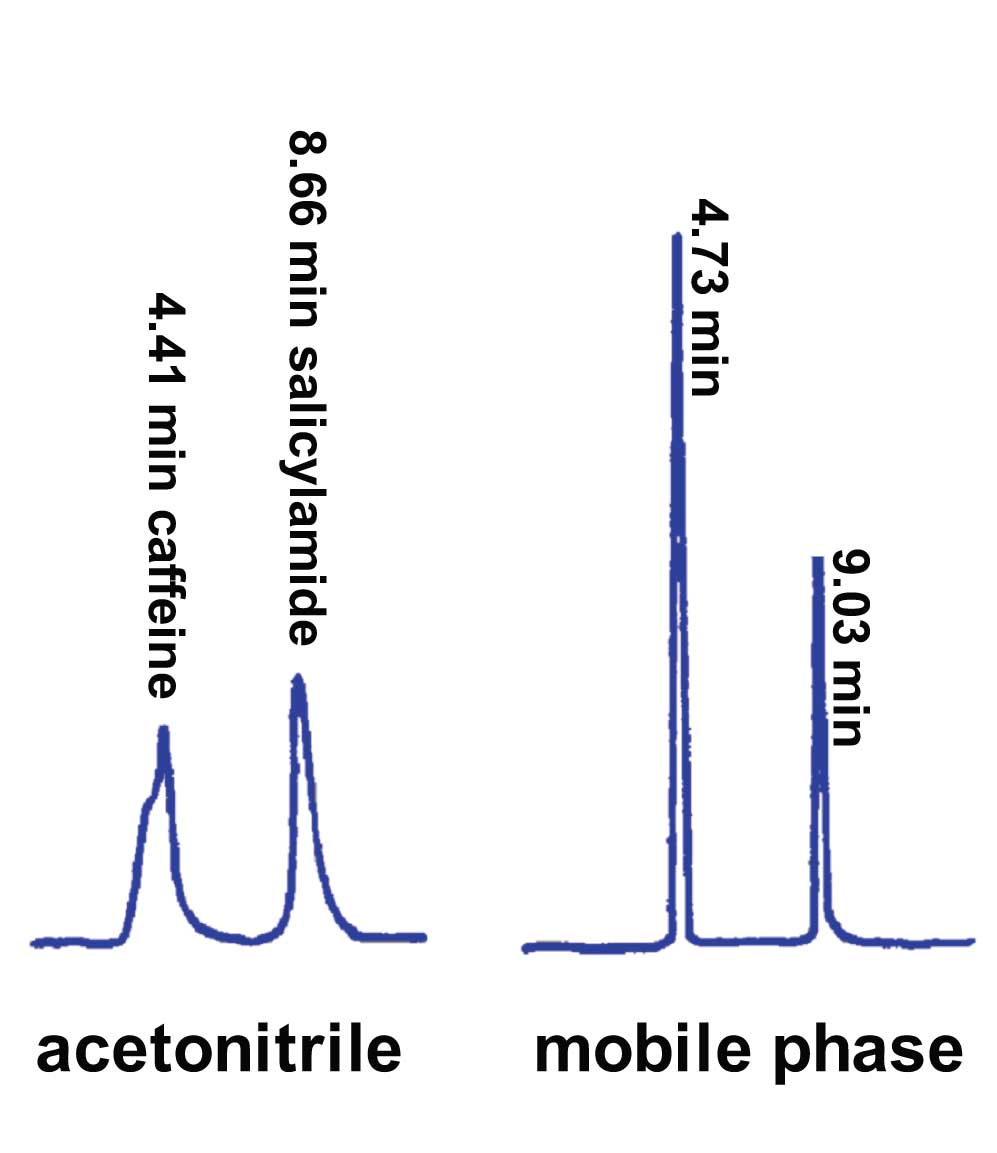Q: I have observed peak splitting in my chromatograms when I inject the sample in tetrahydrofuran (THF) as the injection solvent, but I don’t see any problems when acetonitrile (ACN) is used. I am using a C18 column with a mobile phase of ACN/buffer and an injection volume of 50 µL. Do you have any idea what could be going wrong?
A: I suspect that this is a case of injecting too much of too strong a solvent. Think about the challenge to the HPLC separation when an injection is made. Ideally we want the sample to enter the column in a infinitely small band dissolved in the mobile phase, and, of course, this is never possible. But the further away from this condition we are, the more the separation is compromised. Let’s consider three cases for a method that uses 50/50 acetonitrile (ACN)/buffer as the mobile phase and a 150 x 4.6 mm i.d. column packed with 5 µm particles and operated at a flow rate of 1 mL/min.
Case 1 . Inject a 5 µL sample dissolved in mobile phase. In this case, the sample volume is very small and the injection solvent matches the mobile phase, so it is almost like injecting an infinitely small sample volume in mobile phase. In fact, we could increase the injection volume significantly and not see any appreciable deterioration of the peak quality. As a rule of thumb, we can inject ≈15% of the volume of the first peak of interest without noticeable peak broadening. If we consider a peak of
k = 1 under these conditions, the width would be about 120 µL. This would translate into (15% x 120 µL) ≈ 20 µL allowed. For a later-eluted peak, say k = 5, the width would be ≈330 µL, and ≈ 50 µL could be injected.
Case 2 . Inject a 5 µL sample dissolved in 100% ACN. At injection, the sample molecules are in a solvent that is much stronger than the mobile phase, which means that they will travel more quickly down the column in this stronger solvent until the injection slug gets diluted to the mobile phase concentration. But because the injection volume is small, it is likely that this dilution will take place very quickly, and I doubt if you would notice any increase in peak widths in this case.
Case 3 . Inject a 50 µL sample dissolved in 100% ACN. This is an extension of Case 2, and you can see that it will take longer for the injected solvent to get diluted to mobile phase strength because of the larger volume. This means that sample molecules will travel farther down the column under the influence of the injection solvent than they would in Case 2. Furthermore, if we think of the dilution process acting like peeling the layers off an onion, the sample molecules at the outer edges of the injection will be diluted into the mobile phase before those in the middle of the injection slug. Now you have a case where some sample molecules are travelling at different speeds than others and the sample is smeared across the top of the column during the dilution process. The cure for this is either to change the injection solvent to mobile phase or to reduce the injection volume.
 Figure 1
Figure 1
An example of Case 3 is shown in the Figure 1. For the right chromatogram, 30 µL of sample is injected using the mobile phase (18% ACN) as the injection solvent. The peaks are sharp and well-shaped. When the same sample is injected in 30 µL of 100% ACN, the chromatogram on the left appears. Now the peaks are distorted and they come out earlier than on the right. One way of thinking of this is that the sample molecules are flushed down the column quickly until the injection solvent is diluted to the mobile phase concentration. Reducing the injection volume and/or the injection solvent concentration would fix this.

Figure 2
Now, how does your case fit into this? I suspect that your injection in ACN is very close to the limits of stability of the method. I’ll bet that if you lowered the injection volume of ACN or diluted it so that it was closer to the mobile phase concentration, you would see improved peak shape. When you switch to THF, it is just enough stronger to cause problems. This reminds me of a sign I saw (Figure 2) on a recent trip to Ireland – in too many of our methods we’re operating in a region that appears to be stable, but it only takes a small change in conditions and we tumble off the cliff. Your method is one of these – reduce the injection volume and/or injection solvent strength and you will create a safety margin in your method.
This blog article series is produced in collaboration with John Dolan, best known as one of the world’s foremost HPLC troubleshooting authorities. He is also known for his ongoing research with Lloyd Snyder, resulting in more than 100 technical publications and three books. If you have any questions about this article send them to TechTips@sepscience.com
Reference
[1] T.-L Ng and S. Ng, J. Chromatogr., 389 (1985) 13.




